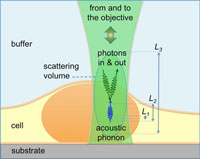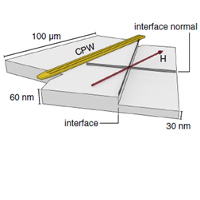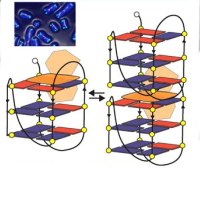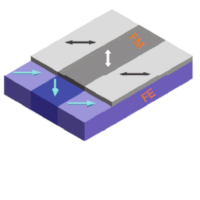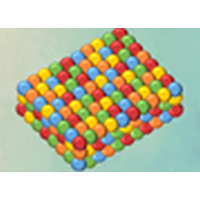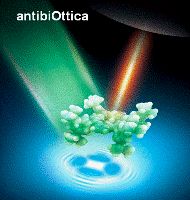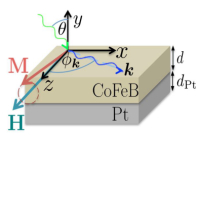A living bio-hybrid system studied by means of a multidisciplinary approach
A multidisciplinary approach to study the functional properties of neuron-like cell models constituting a living bio-hybrid system: SH-SY5Y cells adhering to PANI substrate
One of the more challenging aspects in cognitive or in rehabilitation neurosciences is the design of functional hybrid systems able to mimic the brain functionality, to connect and to exchange information between biological materials, like brain or neurons, and man-made electronic devices.
Here, a living bi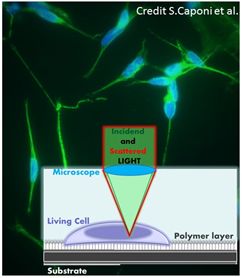 o-hybrid system has been successfully implemented. It is constituted by neuroblastic cells, the SH-SY5Y human neuroblastoma cells, adhering to a poly-anyline (PANI) a semiconductor polymer with memristive properties: it mimics the synapse activity of a nervous system by modifying their conductivity depending on the previous electric history. This peculiar property represents a sort of memory for the device.By a multidisciplinary approach, the biocompatibility of the substrate has been analyzed and the functionality of the adhering cells has been investigated. In order to deeply characterize the modifications of the bio-functionality induced by the cell-substrate interaction, the functional properties of the cells have been characterized by immunocytochemistry, electrophysiology and Raman spectroscopy. Our results confirm that the PANI films do not strongly affect the general properties of the cells, ensuring their viability without toxic effects on their physiology. In this study is the development of an experimental multidisciplinary approach able to characterize in real time the status of the living cells. We applied the analysis on a fully working hybrid bio-inspired device but in a prospective view, this work provide the proof of concept of an integrated study able to analyse the status of living cells in a large variety of applications merging nanosciences, neurosciences and bioelectronics.
o-hybrid system has been successfully implemented. It is constituted by neuroblastic cells, the SH-SY5Y human neuroblastoma cells, adhering to a poly-anyline (PANI) a semiconductor polymer with memristive properties: it mimics the synapse activity of a nervous system by modifying their conductivity depending on the previous electric history. This peculiar property represents a sort of memory for the device.By a multidisciplinary approach, the biocompatibility of the substrate has been analyzed and the functionality of the adhering cells has been investigated. In order to deeply characterize the modifications of the bio-functionality induced by the cell-substrate interaction, the functional properties of the cells have been characterized by immunocytochemistry, electrophysiology and Raman spectroscopy. Our results confirm that the PANI films do not strongly affect the general properties of the cells, ensuring their viability without toxic effects on their physiology. In this study is the development of an experimental multidisciplinary approach able to characterize in real time the status of the living cells. We applied the analysis on a fully working hybrid bio-inspired device but in a prospective view, this work provide the proof of concept of an integrated study able to analyse the status of living cells in a large variety of applications merging nanosciences, neurosciences and bioelectronics.
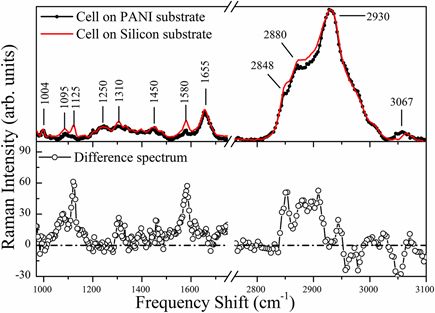
Figure: The upper panel shows Raman spectra of cells adhering on PANI (full dots) and on silicon substrates chosen as a control (red line). Lower panel: difference between the spectra . The difference can be related with the interaction with the substrate. and
The results have been put in evidence by the American Institut of Physics (AIP) in this comment https://www.eurekalert.org/pub_releases/2016-11/aiop-rcl111016.php
also by ANSA (Italian National Press Agency) http://www.ansa.it/scienza/notizie/rubriche/biotech/2016/11/20/un-sistema-di-neuroni-e-chip-elettronico-per-la-riabilitazione-_db1eb072-691c-4814-8310-a26863bd6a5b.html and the italian journal Avvenire https://www.cnr.it/it/canali/giornalisti
The article:"A multidisciplinary approach to study the functional properties of neuron-like cell models constituting a living bio-hybrid system: SH-SY5Y cells adhering to PANI substrate," is authored by S. Caponi, S. Mattana, M. Ricci, K.Sagini, L. J. Juarez-Hernandez, A. M. Jimenez-Garduño, N. Cornella, L. Pasquardini, L. Urbanelli, P. Sassi, A. Morresi, C. Emiliani, D. Fioretto, M. Dalla Serra, C. Pederzolli, S. Iannotta, P. Macchi and C. Musio has been published in AIP Advances 6, 111303 (2016); https://dx.doi.org/10.1063/1.4966587
This work is supported by PAT (Autonomous Province of Trento ITALY) "Large projects 2012" Project "Madelena".

